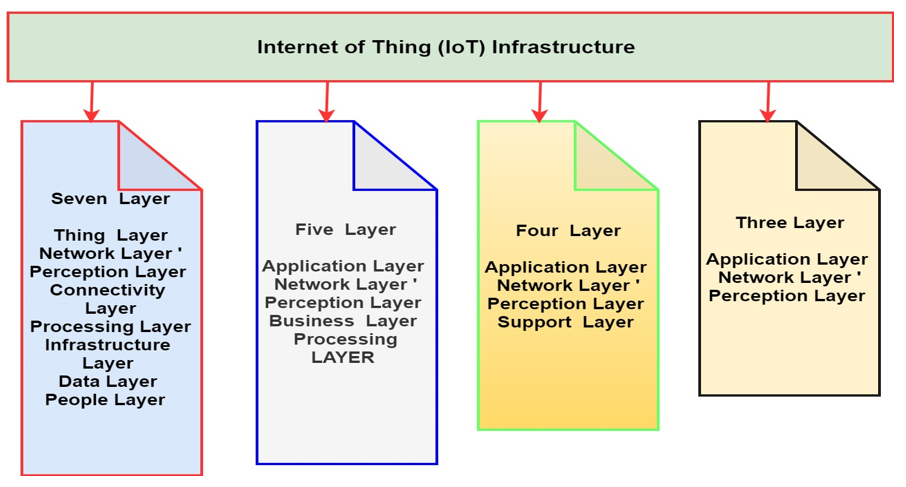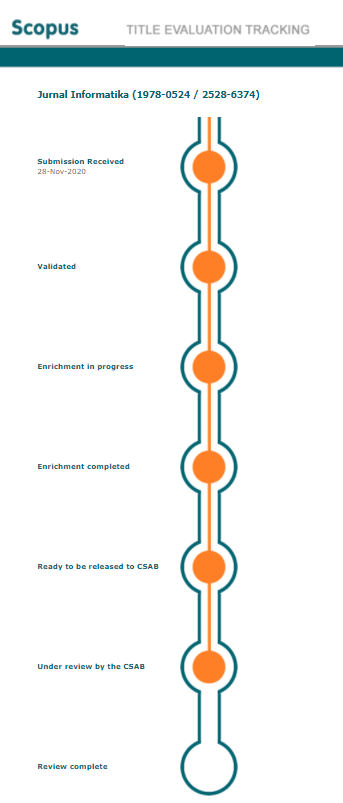
CloudIoT paradigm acceptance for e-learning: analysis and future challenges
Abstract
Keywords
Full Text:
PDFReferences
Ullah, A., Nawi, N. M., Shahzad, A., Khan, S. N., & Aamir, M. (2017). An e-learning system in Malaysia based on green computing and energy level. JOIV: International Journal on Informatics Visualization, 1(4-2), 184-187.
Hashem, I. A. T., Yaqoob, I., Anuar, N. B., Mokhtar, S., Gani, A., & Khan, S. U. (2015). The rise of “big data†on cloud computing: Review and open research issues. Information systems, 47, 98-115.
Mishra, Lalita, and Shirshu Varma. "Middleware Technologies for Smart Wireless Sensor Networks towards Internet of Things: A Comparative Review." Wireless Personal Communications (2020): 1-36.
Vermesan, O., Bröring, A., Tragos, E., Serrano, M., Bacciu, D., Chessa, S., ... & Simoens, P. (2017). Internet of robotic things: converging sensing/actuating, hypoconnectivity, artificial intelligence and IoT Platforms.
Huang, R., Tlili, A., Chang, T. W., Zhang, X., Nascimbeni, F., & Burgos, D. (2020). Disrupted classes, undisrupted learning during COVID-19 outbreak in China: Application of open educational practices and resources. Smart Learning Environments, 7(1), 1-15.
Oyelere, S. S., Bouali, N., Kaliisa, R., Obaido, G., Yunusa, A. A., & Jimoh, E. R. (2020). Exploring the trends of educational virtual reality games: a systematic review of empirical studies. Smart Learning Environments, 7(1), 1-22.
Lanzilotti, R., Ardito, C., Costabile, M. F., & De Angeli, A. (2006). eLSE methodology: a systematic approach to the e-learning systems evaluation. Educational Technology & Society, 9(4), 42-53.
Chao, K. M., James, A. E., Nanos, A. G., Chen, J. H., Stan, S. D., Muntean, I., ... & Cooper, J. (2015). Cloud E-learning for Mechatronics: CLEM. Future Generation Computer Systems, 48, 46-59.
Anderson, P., Bowring, J., McCauley, R., Pothering, G., & Starr, C. (2014, March). An undergraduate degree in data science: curriculum and a decade of implementation experience. In Proceedings of the 45th ACM technical symposium on Computer science education (pp. 145-150).
Gul, S., Asif, M., Ahmad, S., Yasir, M., Majid, M., Malik, M. S. A., & Arshad, S. (2017). A survey on role of internet of things in education. International Journal of Computer Science and Network Security, 17(5), 159-165.
Stephens, K. K., Jahn, J. L., Fox, S., Charoensap-Kelly, P., Mitra, R., Sutton, J., ... & Meisenbach, R. J. (2020). Collective sensemaking around COVID-19: experiences, concerns, and agendas for our rapidly changing organizational lives. Management Communication Quarterly, 34(3), 426-457.
Osman, M. E. (2020). Global impact of COVID-19 on education systems: the emergency remote teaching at Sultan Qaboos University. Journal of Education for Teaching, 1-9.
Kochan, T. A., & Dyer, L. (2020). Shaping the future of work: A handbook for action and a new social contract. Routledge.
Correia, A. P., Liu, C., & Xu, F. (2020). Evaluating videoconferencing systems for the quality of the educational experience. Distance Education, 1-24.
Ullah, A., & Nawi, N. M. (2020). Enhancing the dynamic load balancing technique for cloud computing using HBATAABC algorithm. International Journal of Modeling, Simulation, and Scientific Computing, 2050041.
Xing, L. (2020). Reliability in Internet of Things: Current Status and Future Perspectives. IEEE Internet of Things Journal.
Tavana, M., Hajipour, V., & Oveisi, S. (2020). IoT-based Enterprise Resource Planning: Challenges, Open Issues, Applications, Architecture, and Future Research Directions. Internet of Things, 100262.
Houlden, S., & Veletsianos, G. (2020). The problem with flexible learning: Neoliberalism, freedom, and learner subjectivities. Learning, Media and Technology, 1-12.
Sotiriou, S. A., Lazoudis, A., & Bogner, F. X. (2020). Inquiry-based learning and E-learning: how to serve high and low achievers. Smart Learning Environments, 7(1), 1-15.
Khlifi, Y. (2020). An Advanced Authentication Scheme for E-evaluation Using Students Behaviors Over E-learning Platform. International Journal of Emerging Technologies in Learning (iJET), 15(04), 90-111.
Ashwin, T. S., & Guddeti, R. M. R. (2020). Impact of inquiry interventions on students in e-learning and classroom environments using affective computing framework. User Modeling and User-Adapted Interaction, 1-43.
Xu, X., Chan, F. M., & Yilin, S. (2020). Personal learning environment: an experience with ESP teacher training. Interactive Learning Environments, 28(6), 779-794.
Wargadinata, W., Maimunah, I., Eva, D., & Rofiq, Z. (2020). Student’s responses on learning in the early COVID-19 pandemic. Tadris: Journal of Education and Teacher Training, 5(1), 141-153.
Gajendran, N. (Ed.). (2020). Blockchain-Based secure framework for e-learning during COVID-19. Indian journal of science and technology, 13(12), 1328-1341.
Ullah, A. (2019). Artificial bee colony algorithm used for load balancing in cloud computing. IAES International Journal of Artificial Intelligence, 8(2), 156.
Kakkad, V., Patel, M., & Shah, M. (2019). Biometric authentication and image encryption for image security in cloud framework. Multiscale and Multidisciplinary Modeling, Experiments and Design, 2(4), 233-248.
Al-Samarraie, H., & Saeed, N. (2018). A systematic review of cloud computing tools for collaborative learning: Opportunities and challenges to the blended-learning environment. Computers & Education, 124, 77-91.
Atzori, L., Iera, A., & Morabito, G. (2017). Understanding the Internet of Things: definition, potentials, and societal role of a fast evolving paradigm. Ad Hoc Networks, 56, 122-140.
Ghahramani, M. H., Zhou, M., & Hon, C. T. (2017). Toward cloud computing QoS architecture: Analysis of cloud systems and cloud services. IEEE/CAA Journal of Automatica Sinica, 4(1), 6-18.
Koch, C. (2017). Social cognition and social learning theories of education and technology. Retrieved on 15th August.
Aceto, G., Persico, V., & Pescapé, A. (2020). Industry 4.0 and health: Internet of things, big data, and cloud computing for healthcare 4.0. Journal of Industrial Information Integration, 18, 100129.
Estevez, C. (2016). Addressing Transport Layer Issues in Cloud Computing: A STEM Perspective. In Handbook of Research on Cloud-Based STEM Education for Improved Learning Outcomes (pp. 79-93). IGI Global.
Behera, S. K. (2013). E-and M-Learning: A comparative study. International Journal on New Trends in Education and Their Implications, 4(3), 65-78.
Xu, X. (2012). From cloud computing to cloud manufacturing. Robotics and computer-integrated manufacturing, 28(1), 75-86.
Hamburg, I., & Marian, M. (2012). Learning as a service–a cloud-based approach for SMEs. Service computation, 53-57.
Park, Y. (2011). A pedagogical framework for mobile learning: Categorizing educational applications of mobile technologies into four types. International Review of Research in Open and Distributed Learning, 12(2), 78-102.
Yang, C., Wu, H., Huang, Q., Li, Z., & Li, J. (2011). Using spatial principles to optimize distributed computing for enabling the physical science discoveries. Proceedings of the National Academy of Sciences, 108(14), 5498-5503.
Liaw, S. S., Hatala, M., & Huang, H. M. (2010). Investigating acceptance toward mobile learning to assist individual knowledge management: Based on activity theory approach. Computers & Education, 54(2), 446-454.
Horton, W., & Horton, K. (2003). E-learning Tools and Technologies: A consumer's guide for trainers, teachers, educators, and instructional designers. John Wiley & Sons.
Pollard, E., & Hillage, J. (2001). Exploring e-learning. Brighton: Institute for Employment Studies.
Galindo, A., Jackson, G., & Photinos, D. J. (2000). Computer simulation of the interface between two liquid crystalline phases in rod–plate binary mixtures. Chemical Physics Letters, 325(5-6), 631-638.
Knapper, C., & Cropley, A. J. (2000). Lifelong learning in higher education. Psychology Press.
Adams, M., & Fraden, S. (1998). Phase behavior of mixtures of rods (tobacco mosaic virus) and spheres (polyethylene oxide, bovine serum albumin). Biophysical journal, 74(1), 669-677.
Khan, A. (1996). Phase science of surfactants. Current Opinion in Colloid & Interface Science, 1(5), 614-623.
Dahdouh, K., Oughdir, L., Dakkak, A., & Ibriz, A. (2018, October). Smart Courses Recommender System for Online Learning Platform. In 2018 IEEE 5th International Congress on Information Science and Technology (CiSt) (pp. 328-333). IEEE.
Oyelami, A. T., Akinade, A. S., & Obianefo, K. C. (2020). Development of a real-time framework for farm monitoring using drone technology. IAES International Journal of Robotics and Automation, 9(4), 244.
Martins, W. M., Dantas Filho, A. J., Dejesus, L. D., Desouza, A. D., Ramos, A. C., & Pimenta, T. C. (2020). Tracking for inspection in energy transmission power lines using unmanned aerial vehicles: a systematic review of current and specific literature. IAES International Journal of Robotics and Automation, 9(4), 233.
Van, C. N. (2020). The algorithm of adaptive control for active suspension systems using pole assign and cascade design method. IAES International Journal of Robotics and Automation, 9(4), 271.
Xu, D., Chen, Y. L., Lin, C., Kong, X., & Wu, X. (2012, December). Real-time dynamic gesture recognition system based on depth perception for robot navigation. In 2012 IEEE International Conference on Robotics and Biomimetics (ROBIO) (pp. 689-694). IEEE.
Rautaray, S. S. (2012). Real time hand gesture recognition system for dynamic applications. International Journal of UbiComp (IJU), 3(1).
Srasrisom, K., Srinoi, P., Chaijit, S., & Wiwatwongwana, F. (2020). Improvement of an automated CAN packaging system based on modeling and analysis approach through robot simulation tools. IAES International Journal of Robotics and Automation, 9(3), 178.
Purwani, F., Jalinus, N., & Ambiyar, A. (2017). The Design of Lecturer Performance Evaluation Model Based on Analytic Network Process (ANP).
Kumalasari, D., Putra, A. B. W., & Gaffar, A. F. O. (2020). Speech classification using combination virtual center of gravity and k-means clustering based on audio feature extraction. J. Inform, 14(2), 85.
Benbouras, M. A., Kettab, R. M., Zedira, H., Debiche, F., & Zaidi, N. (2018). Comparing nonlinear regression analysis and artificial neural networks to predict geotechnical parameters from standard penetration test. Urbanism. Architecture. Constructions/Urbanism. Arhitectura. Constructii, 9(3).
Untoroa, M. C., Sarnoa, R., & Ariyania, N. F. (2018). Reusability ontology in business processes with similarity matching. Jurnal Informatika, 12(1), 9-16.
Pramanik, P. K. D., Mukherjee, B., Pal, S., Upadhyaya, B. K., & Dutta, S. (2020). Ubiquitous manufacturing in the age of industry 4.0: a state-of-the-art primer. In A Roadmap to Industry 4.0: Smart Production, Sharp Business and Sustainable Development (pp. 73-112). Springer, Cham.
Calvo, J. (2020). Journey of the Future Enterprise: How to Compete in the Age of Moonshot Leadership and Exponential Organizations. Libros de Cabecera.
Naha, R. K., Garg, S., & Chan, A. (2018). Fog computing architecture: Survey and challenges. arXiv preprint arXiv:1811.09047.
Elazhary, H. (2019). Internet of Things (IoT), mobile cloud, cloudlet, mobile IoT, IoT cloud, fog, mobile edge, and edge emerging computing paradigms: Disambiguation and research directions. Journal of Network and Computer Applications, 128, 105-140.
Dong, Zhao Yang, Yuchen Zhang, Christine Yip, Sharon Swift, and Kim Beswick. "Smart campus: definition, framework, technologies, and services." IET Smart Cities 2, no. 1 (2020): 43-54.
Zhong, R. Y., Xu, X., Klotz, E., & Newman, S. T. (2017). Intelligent manufacturing in the context of industry 4.0: a review. Engineering, 3(5), 616-630.
Mayoof, S., Alaswad, H., Aljeshi, S., Tarafa, A., & Elmedany, W. (2021). A hybrid circuits-cloud: Development of a low-cost secure cloud-based collaborative platform for A/D circuits in virtual hardware E-lab. Ain Shams Engineering Journal, 12(2), 1197-1209.
Alalade, A. M., Ejemeyovwi, J. O., Ekong, E. E., & Adeyemo, A. D. (2019). Internet of things as a tool for enhancement of education administration and delivery. International Journal of Mechanical Engineering and Technology, 10(5), 48-62.
Singh, A. (2019). IMPLEMENTATION OF THE IOT AND CLOUD TECHNOLOGIES IN EDUCATION SYSTEM.(CASE STUDY OF INDIA). International Journal of New Economics and Social Sciences IJONESS, 9(1), 353-362.
Rodićâ€TrmÄić, B., Labus, A., Barać, D., Popović, S., & Radenković, B. (2018). Designing a course for smart healthcare engineering education. Computer Applications in Engineering Education, 26(3), 484-499.
Roblek, V., Meško, M., Bach, M. P., Thorpe, O., & Šprajc, P. (2020). The interaction between internet, sustainable development, and emergence of society 5.0. Data, 5(3), 80.
Sandhu, K. Emerging Challenges, Solutions, and Best Practices for Digital Enterprise Transformation 9781799885870, 9781799885900.
DOI: http://dx.doi.org/10.26555/jifo.v16i3.a21744
Refbacks
- There are currently no refbacks.
Copyright (c) 2022 Arif Ullah, Hanane Aznaoui, Canan Batur Sahin, Ikram Daanoune ,Ozlem Batur Dinle

This work is licensed under a Creative Commons Attribution-ShareAlike 4.0 International License.
____________________________________
JURNAL INFORMATIKA
ISSN :Â 1978-0524 (print) | 2528-6374 (online)

This work is licensed under a Creative Commons Attribution-ShareAlike 4.0 International License.






